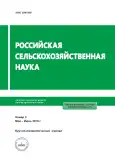Modern technologies of robotized cowing milk
- Authors: Kiselev L.Y.1, Kamalov R.A.1, Borisov M.Y.1, Fedoseeva N.A.1, Sanova Z.S.1
-
Affiliations:
- Russian State Agrarian Correspondence University
- Issue: No 3 (2019)
- Pages: 54-57
- Section: Animal husbandry
- URL: https://journals.eco-vector.com/2500-2627/article/view/14313
- DOI: https://doi.org/10.31857/S2500-26272019354-57
- ID: 14313
Cite item
Abstract
The studies were conducted in the conditions of LLC “Milk Group” of Sukhinichsky district of Kaluga region. The object of research is robotic milking machines, Swedish breed cows and Danish red breeds. Equality of development of the front and rear lobes, the udder index, the average milk flow rate and the frequency of delivery can be achieved only with long-term selection by type, good severity of signs of milkiness. Based on the selection of cows for milking on a robotized milking plant, the following requirements were put forward: high milk productivity and milk yield, tightly attached udder, nipples of the same size, the lower point of which should not be below 33 cm from the floor level, the minimum distance between the rear nipples in 3 cm, between the front nipples - 12.5 - 30 cm, the thickness of the nipples in the range of 1.5-3.5 cm, the rear nipples should be located 3 cm lower than the lower part of the udder, the minimum distance between the front and rear These udder teats - 7 cm, an angle of deviation from vertical teats should not exceed 30 °. The main reasons for the insignificant loss of milk during robotic milking are the milking of cows that do not have a full-fledged milk-giving reflex or the reflex was inhibited at the beginning of the milking of milk with a delay in putting the teat on the teats of the udder. The size of one-time milk yield, with the exception of the program indicators of this restriction on the milk yield, is determined by the frequency of effective visits to the robot (i.e., the multiplicity of milking during the day). In robotic milking, the frequency of milkings varies by day periods relatively little and drops to a minimum only in the second half of the night, in our opinion, due to the relatively late distribution of feed mixtures. It is also noted that cows of all ages have the same number of milkings on a robotized unit within 2 times.
Keywords
Full Text
About the authors
L. Yu. Kiselev
Russian State Agrarian Correspondence University
Author for correspondence.
Email: NFedoseeva0208@yandex.ru
doctor of agricultural sciences
Russian Federation, 143900, Moscow region, Balashikha, ul. Yu. Fucik, 1R. A. Kamalov
Russian State Agrarian Correspondence University
Email: NFedoseeva0208@yandex.ru
doctor of veterinary sciences
Russian Federation, 143900, Moscow region, Balashikha, ul. Yu. Fucik, 1M. Yu. Borisov
Russian State Agrarian Correspondence University
Email: NFedoseeva0208@yandex.ru
doctor of economical sciences
Russian Federation, 143900, Moscow region, Balashikha, ul. Yu. Fucik, 1N. A. Fedoseeva
Russian State Agrarian Correspondence University
Email: NFedoseeva0208@yandex.ru
doctor of agricultural sciences
Russian Federation, 143900, Moscow region, Balashikha, ul. Yu. Fucik, 1Z. S. Sanova
Russian State Agrarian Correspondence University
Email: NFedoseeva0208@yandex.ru
candidate of agricultural sciences
Russian Federation, 143900, Moscow region, Balashikha, ul. Yu. Fucik, 1References
- Ведомственная целевая программа «Создание 100 роботизированных молочных ферм в Калужской области» на 2014-2016 гг. – Калуга: МСХ Калужской области, 2013. – 25 с.
- Федосеева Н.А., Санова З.С., Мазуров В.Н. Доение коров с использованием роботизированных доильных установок в условиях Калужской области // Вестник Мичуринского ГА, – 2016. – №1 – С. 56-61.
- Федосеева Н.А., Санов, З.С., Ананьева Е.В. Ретроспектива производства молока и автоматизации доения коров в условиях Калужской области // Инновации и инвестиции. – 2017. – №2. – С. 215-218.
- Государственная программа «Развитие сельского хозяйства и регулирования рынков сельскохозяйственной продукции, сырья и продовольствия в Калужской области». – Калуга: МСХ Калужской области, 2013. – 11 с.
- Закревский А., Хукстра А. Доильный робот в России – быть или не быть? // Сельскохозяйственные вести. – 2008. – №4. – С. 3-4.
- Санова З.С., Федосеева Н.А., Ананьева Е.В. Некоторые рекомендации доения коров на роботизированных доильных установках // Инновации и инвестиции». – 2016. – №12. – С. 192-194
- Федосеева Н.А., Санов, З.С., Ананьева Е.В. Экономическая оценка различных технологий доения коров в хозяйствах Калужской области // Вестник РГАЗУ. – 2017. – №24(29). – С. 21-29.
- Основы современного производства молока // Под ред. проф. Н.М. Костомахина. – Венгрия, Буди, Рада пуста: Хунланд Трейд Кфт., 2011. – 62 с.
- Роботизированные молочные фермы Калужской области. / Информационный бюллетень, Выпуск №1, 2014 .– 5 с.
- Санова З.С., Федосеева Н.А., Новикова Н.Н. Красно-пестрая порода в условиях Калужской области // Вестник Мичуринского ГАУ. – 2018. – №1. – С.69 – 72.
- Трофимо, А.Ф., Тимошенко В.Н., Музыка А.А. Обеспечение основных процессов производства молока при доении на роботизированных установках // Матер. конф. "Современные технологии сельскохозяйственного производства": XII Междунар. науч. - практич. конф. УО"ГГАУ". – Гродно, 2009. – 138 с.
- Холманов, А, Осадчая, О., Алексеенко, А. Доильные роботы: преимущества и проблемы // Животноводство России. – 2008. – №5. – С. 28-30.
- Meskens L., Mathijs E. Socio-economicas pectsofautomatic milking, Motivation and characteristics of farmers in vesting in automatic milking systems, Deliverable D2projectEU: Implications of the introduction of automatic milking systems, 2002. -16 pp.
- Санова З.С., Федосеева Н.А., Мышкина М.С., Иванова Н.И. Порода – как гарант эффективного производства молока в Калужской области // Вестник Мичуринского ГАУ. – 2016. – №2. – С. 70-76.
- Трофимов А.Ф., Тимошенко В.Н., Музыка А.А. Направления совершенствования технологий производства молока // Инновации - приоритетный путь развития АПК: сбор. Матер. VIII Междунар. науч. – практ. конф. – Кемерово, 2009. – С. 132-139
Supplementary files











